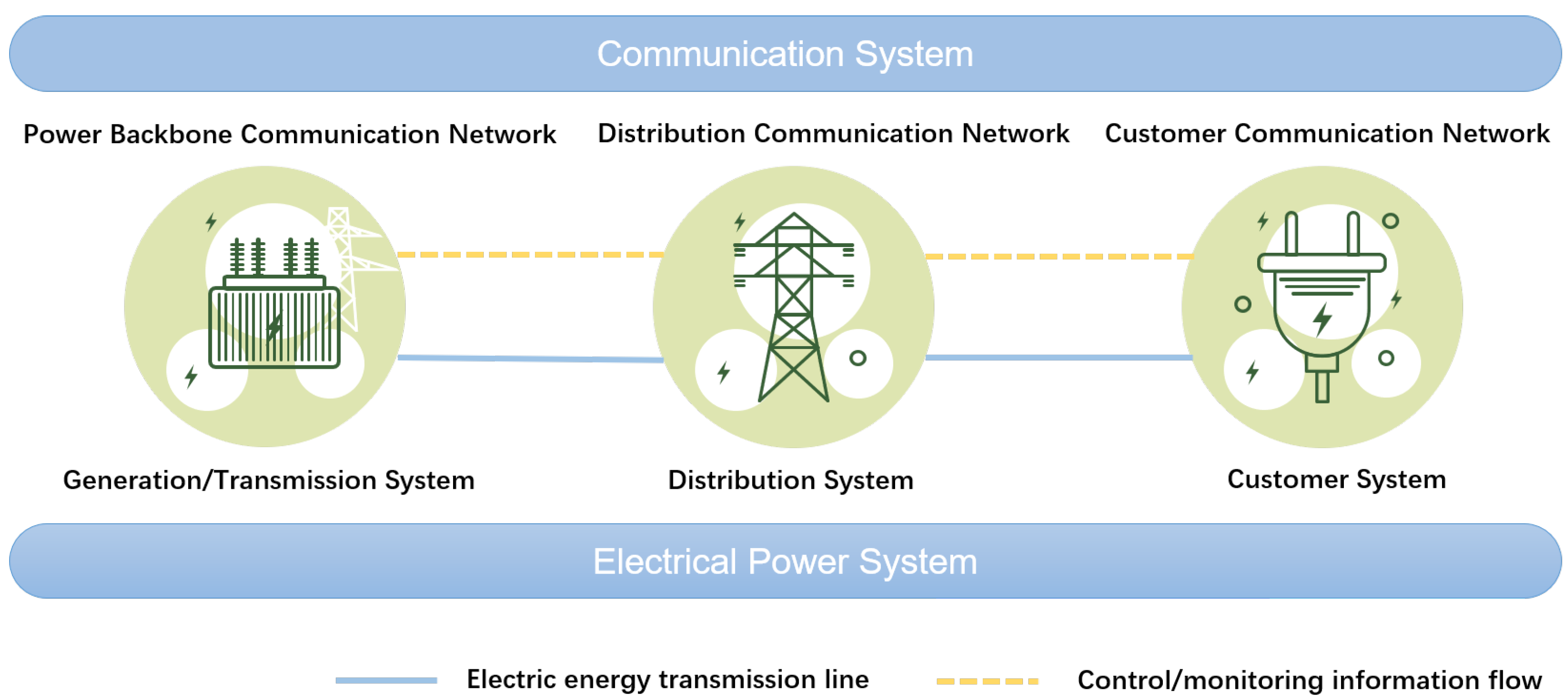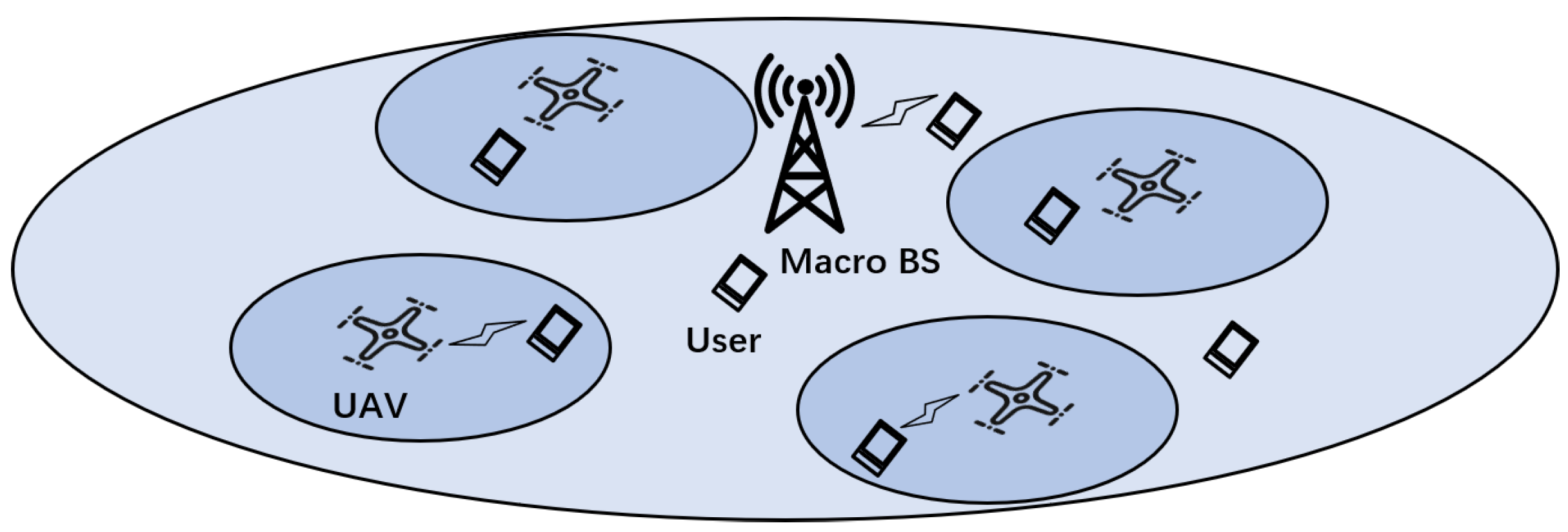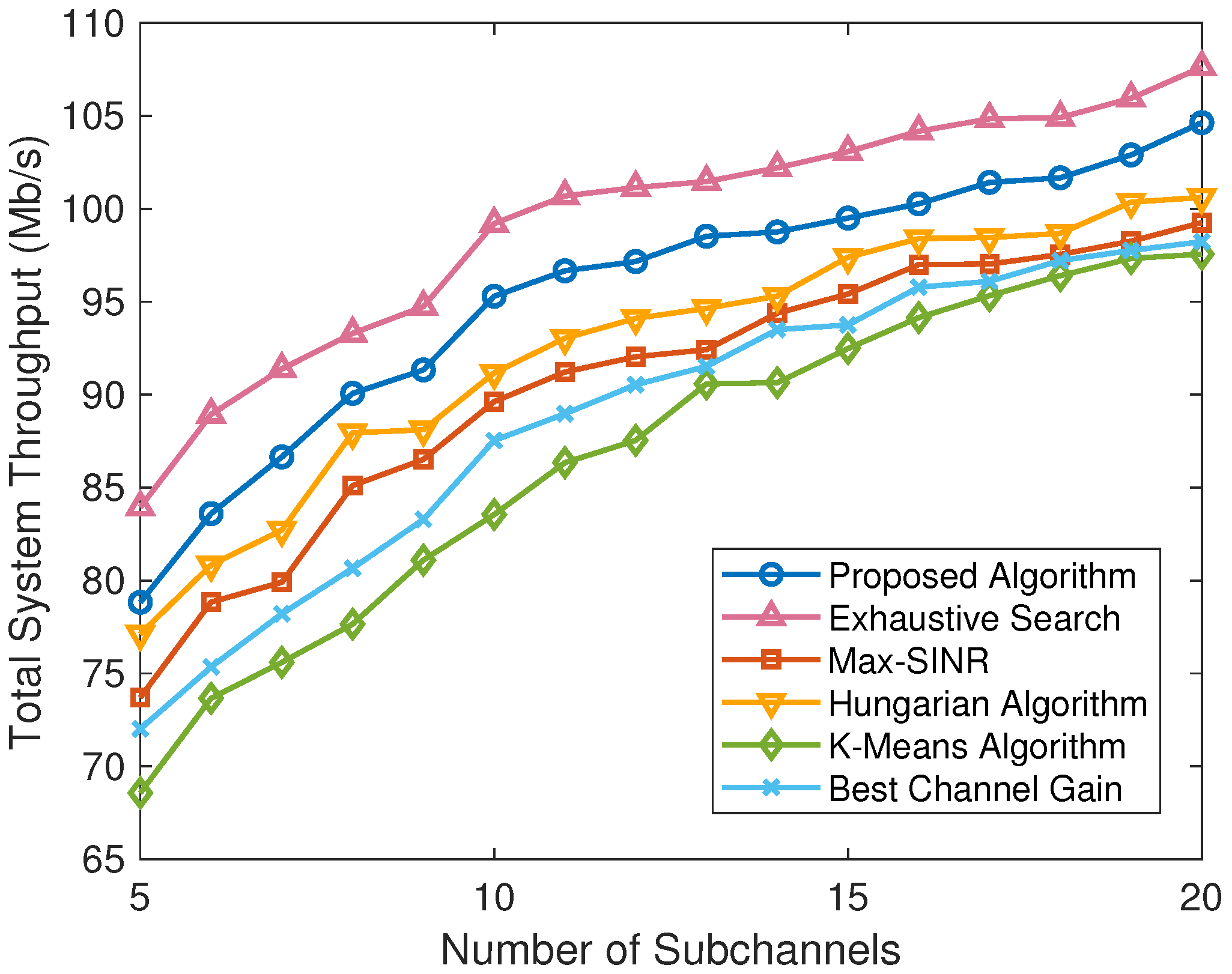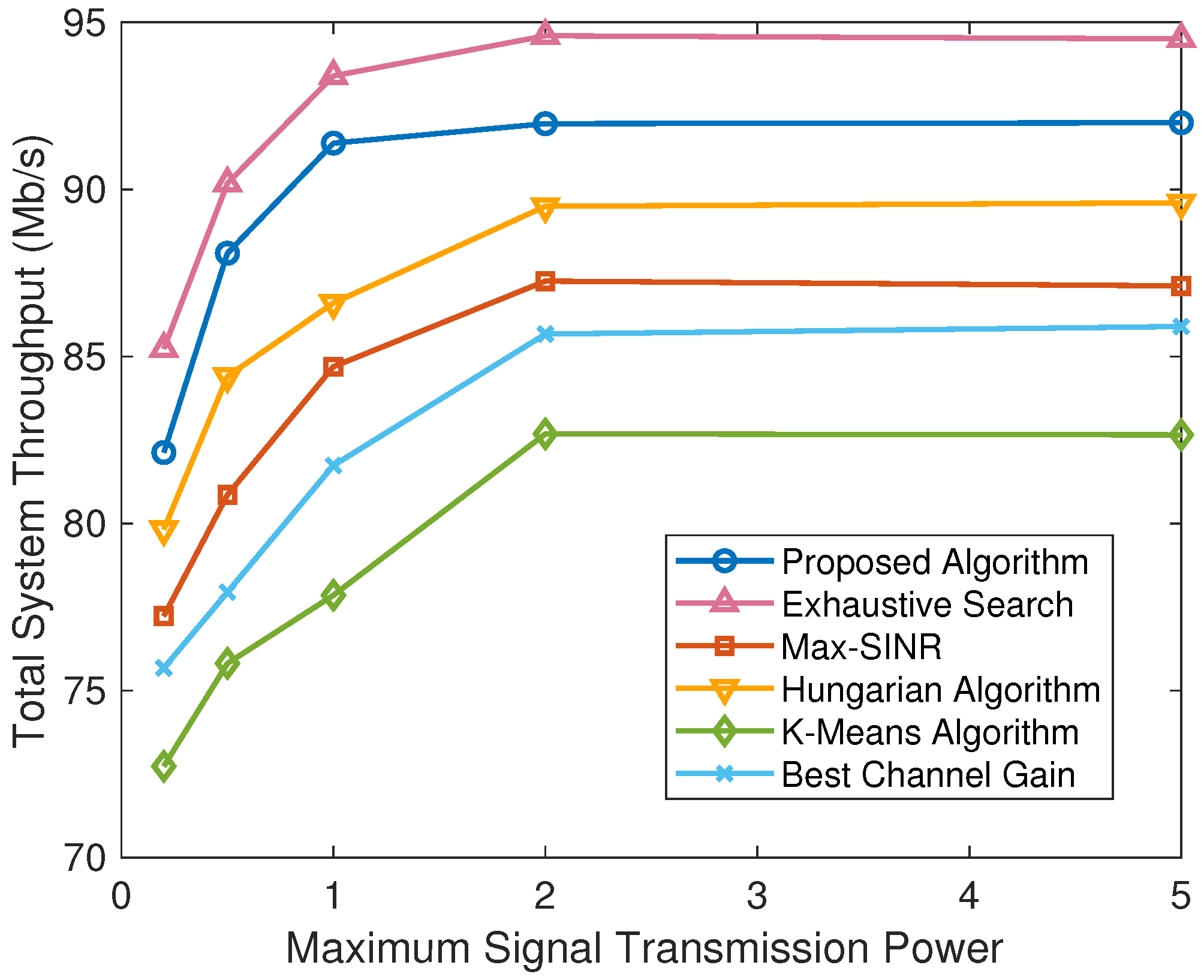A User Association and Resource Allocation Algorithm for UAV-Assisted Smart Grid
Abstract
1. Introduction
- UAV-assisted heterogeneous network architecture for the SG: A UAV-assisted heterogeneous network framework is proposed for SG communication scenarios. The power terminal can flexibly select the BSs equipped on UAVs or macro BSs for communication. The framework can meet the communication demand in remote areas without sufficient communication coverage.
- Joint user association and resource allocation optimization algorithm: To further improve the system capacity of the SG, we formulate the optimization problem to jointly optimize the user association, subchannel allocation and power allocation. To efficiently solve this problem, a joint optimization method based on matching algorithm and Lagrangian dual algorithm is proposed. Therein, based on the proposed user-side and BS-side utility functions, the heuristic algorithm can obtain suboptimal solutions with low complexity.
2. System Model and Problem Formulation
2.1. System Model
2.2. Problem Formulation
3. Joint User Association and Resource Allocation Algorithm
3.1. User Association Optimization
| Algorithm 1 User association based on matching algorithm. |
|
3.2. Subchannel Assignment Optimization
| Algorithm 2 Subchannel assignment based on matching algorithm. |
|
3.3. Power Allocation Optimization
| Algorithm 3 Power allocation algorithm based on Lagrange dual method. |
|
3.4. Discussion
4. Simulation Results and Analysis
4.1. Simulation Setup
4.2. Numerical Evaluation
- Max-SINR algorithm: The max-SINR is adopted for user association as in [43], and the proposed Algorithm 2 is still used for subchannel assignment.
- Hungarian algorithm: The Hungarian algorithm is adopted for user association and subchannel assignment to find the maximum match as in [44].
- Best channel gain algorithm: Users select the BS and subchannel with the best channel gain as in [46].
5. Conclusions
Author Contributions
Funding
Institutional Review Board Statement
Informed Consent Statement
Data Availability Statement
Conflicts of Interest
References
- Dileep, G. A survey on smart grid technologies and applications. Renew. Energy 2020, 146, 2589–2625. [Google Scholar] [CrossRef]
- Judge, M.A.; Khan, A.; Manzoor, A.; Khattak, H.A. Overview of smart grid implementation: Frameworks, impact, performance and challenges. J. Energy Storage 2022, 49, 104056. [Google Scholar] [CrossRef]
- Chong, A.T.Y.; Mahmoud, M.A.; Lim, F.C.; Kasim, H. A review of smart grid technology, components, and implementation. In Proceedings of the 2020 8th International Conference on Information Technology and Multimedia (ICIMU), Selangor, Malaysia, 24–25 August 2020; pp. 166–169. [Google Scholar] [CrossRef]
- Bhat, S. Leveraging 5g network capabilities for smart grid communication. J. Electr. Syst. 2024, 20, 2272–2283. [Google Scholar] [CrossRef]
- Abrahamsen, F.E.; Ai, Y.; Cheffena, M. Communication technologies for smart grid: A comprehensive survey. Sensors 2021, 21, 8087. [Google Scholar] [CrossRef] [PubMed]
- Qays, M.O.; Ahmad, I.; Abu-Siada, A.; Hossain, M.L.; Yasmin, F. Key communication technologies, applications, protocols and future guides for IoT-assisted smart grid systems: A review. Energy Rep. 2023, 9, 2440–2452. [Google Scholar] [CrossRef]
- Panda, D.K.; Das, S. Smart grid architecture model for control, optimization and data analytics of future power networks with more renewable energy. J. Clean. Prod. 2021, 301, 126877. [Google Scholar] [CrossRef]
- Chin, W.L.; Lin, Y.H.; Chen, H.H. A framework of machine-to-machine authentication in smart grid: A two-layer approach. IEEE Commun. Mag. 2016, 54, 102–107. [Google Scholar] [CrossRef]
- Le, T.N.; Chin, W.L.; Chen, H.H. Standardization and security for smart grid communications based on cognitive radio technologies—A comprehensive survey. IEEE Commun. Surv. Tutor. 2016, 19, 423–445. [Google Scholar] [CrossRef]
- Ghorbanian, M.; Dolatabadi, S.H.; Masjedi, M.; Siano, P. Communication in smart grids: A comprehensive review on the existing and future communication and information infrastructures. IEEE Syst. J. 2019, 13, 4001–4014. [Google Scholar] [CrossRef]
- Khan, F.; ur Rehman, A.; Arif, M.; Aftab, M.; Jadoon, B.K. A survey of communication technologies for smart grid connectivity. In Proceedings of the 2016 International Conference on Computing, Electronic and Electrical Engineering (ICE Cube), Quetta, Pakistan, 11–12 April 2016; pp. 256–261. [Google Scholar] [CrossRef]
- Tightiz, L.; Yang, H. A comprehensive review on IoT protocols’ features in smart grid communication. Energies 2020, 13, 2762. [Google Scholar] [CrossRef]
- Rehmani, M.H.; Reisslein, M.; Rachedi, A.; Erol-Kantarci, M.; Radenkovic, M. Integrating renewable energy resources into the smart grid: Recent developments in information and communication technologies. IEEE Trans. Ind. Inform. 2018, 14, 2814–2825. [Google Scholar] [CrossRef]
- Nawaz, H.; Ali, H.M.; Laghari, A.A. UAV communication networks issues: A review. Arch. Comput. Methods Eng. 2021, 28, 1349–1369. [Google Scholar] [CrossRef]
- Meng, K.; Wu, Q.; Xu, J.; Chen, W.; Feng, Z.; Schober, R.; Swindlehurst, A.L. UAV-enabled integrated sensing and communication: Opportunities and challenges. IEEE Wirel. Commun. 2024, 31, 97–104. [Google Scholar] [CrossRef]
- Shahzadi, R.; Ali, M.; Khan, H.Z.; Naeem, M. UAV assisted 5G and beyond wireless networks: A survey. J. Netw. Comput. Appl. 2021, 189, 103114. [Google Scholar] [CrossRef]
- Marabissi, D.; Mucchi, L.; Morosi, S. User-cell association for security and energy efficiency in ultra-dense heterogeneous networks. Sensors 2021, 21, 508. [Google Scholar] [CrossRef] [PubMed]
- Bikram Kumar, B.; Sharma, L.; Wu, S.L. Online distributed user association for heterogeneous radio access network. Sensors 2019, 19, 1412. [Google Scholar] [CrossRef] [PubMed]
- Zhang, S.; Kang, G. User association and power control for energy efficiency maximization in M2M-enabled uplink heterogeneous networks with NOMA. Sensors 2019, 19, 5307. [Google Scholar] [CrossRef]
- Hu, S.; Chen, X.; Ni, W.; Wang, X.; Hossain, E. Modeling and analysis of energy harvesting and smart grid-powered wireless communication networks: A contemporary survey. IEEE Trans. Green Commun. Netw. 2020, 4, 461–496. [Google Scholar] [CrossRef]
- Liu, D.; Wang, L.; Chen, Y.; Elkashlan, M.; Wong, K.K.; Schober, R.; Hanzo, L. User association in 5G networks: A survey and an outlook. IEEE Commun. Surv. Tutor. 2016, 18, 1018–1044. [Google Scholar] [CrossRef]
- Ramazanali, H.; Mesodiakaki, A.; Vinel, A.; Verikoukis, C. Survey of user association in 5G HetNets. In Proceedings of the 2016 8th IEEE Latin-American conference on communications (LATINCOM), Medellin, Colombia, 15–17 November 2016; pp. 1–6. [Google Scholar] [CrossRef]
- Yadav, A.K.; Singh, K.; Arshad, N.I.; Ferrara, M.; Ahmadian, A.; Mesalam, Y.I. MADM-based network selection and handover management in heterogeneous network: A comprehensive comparative analysis. Results Eng. 2024, 21, 101918. [Google Scholar] [CrossRef]
- Chou, H. A heterogeneous wireless network selection algorithm for smart distribution grid based on chi-square distance. In Proceedings of the 2018 10th International Conference on Communications, Circuits and Systems (ICCCAS), Chengdu, China, 22–24 December 2018; pp. 325–330. [Google Scholar] [CrossRef]
- Alhashimi, H.F.; Hindia, M.N.; Dimyati, K.; Hanafi, E.B.; Izam, T.F.T.M.N. Joint optimization scheme of user association and channel allocation in 6G hetnets. Symmetry 2023, 15, 1673. [Google Scholar] [CrossRef]
- Huang, B.; Guo, A. A dynamic hierarchical game approach for user association and resource allocation in HetNets with wireless backhaul. IEEE Wirel. Commun. Lett. 2024, 13, 59–63. [Google Scholar] [CrossRef]
- Khawam, K.; Lahoud, S.; El Helou, M.; Martin, S.; Gang, F. Coordinated framework for spectrum allocation and user association in 5G HetNets with mmWave. IEEE Trans. Mob. Comput. 2020, 21, 1226–1243. [Google Scholar] [CrossRef]
- Yadav, A.K.; Singh, K.; Srivastava, P.K. Probabilistic estimation of comprehensive utility based on user preference and network condition for network selection in future in HetNet. J. Supercomput. 2024, 80, 4378–4400. [Google Scholar] [CrossRef]
- Montalban, J.; Muntean, G.M.; Angueira, P. A utility-based framework for performance and energy-aware convergence in 5G heterogeneous network environments. IEEE Trans. Broadcast. 2020, 66, 589–599. [Google Scholar] [CrossRef]
- Liu, Y.; Liu, K.; Han, J.; Zhu, L.; Xiao, Z.; Xia, X.G. Resource allocation and 3-D placement for UAV-enabled energy-efficient IoT communications. IEEE Internet Things J. 2021, 8, 1322–1333. [Google Scholar] [CrossRef]
- Chiti, F.; Fantacci, R.; Gu, Y.; Han, Z. Content sharing in Internet of Vehicles: Two matching-based user-association approaches. Veh. Commun. 2017, 8, 35–44. [Google Scholar] [CrossRef]
- LeAnh, T.; Tran, N.H.; Saad, W.; Le, L.B.; Niyato, D.; Ho, T.M.; Hong, C.S. Matching theory for distributed user association and resource allocation in cognitive femtocell networks. IEEE Trans. Veh. Technol. 2017, 66, 8413–8428. [Google Scholar] [CrossRef]
- Gharagezlou, A.S.; Nangir, M.; Imani, N. Energy efficient power allocation with joint antenna and user selection in massive MIMO systems. Comput. Netw. 2022, 216, 109225. [Google Scholar] [CrossRef]
- Adam, A.B.; Wan, X.; Wang, Z. User scheduling and power allocation for downlink multi-cell multi-carrier NOMA systems. Digit. Commun. Netw. 2023, 9, 252–263. [Google Scholar] [CrossRef]
- Han, J.; Lee, G.H.; Park, S.; Choi, J.K. Joint subcarrier and transmission power allocation in OFDMA-based WPT system for mobile-edge computing in IoT environment. IEEE Internet Things J. 2022, 9, 15039–15052. [Google Scholar] [CrossRef]
- Benedek, M.; Biro, P.; Johnson, M.; Paulusma, D.; Ye, X. The complexity of matching games: A survey. J. Artif. Intell. Res. 2023, 77, 459–485. [Google Scholar] [CrossRef]
- Biró, P.; Kern, W.; Paulusma, D. Computing solutions for matching games. Int. J. Game Theory 2012, 41, 75–90. [Google Scholar] [CrossRef]
- Pólik, I.; Terlaky, T. Interior Point Methods for Nonlinear Optimization; Springer: Berlin/Heidelberg, Germany, 2010. [Google Scholar] [CrossRef]
- Potra, F.A.; Wright, S.J. Interior-point methods. J. Comput. Appl. Math. 2000, 124, 281–302. [Google Scholar] [CrossRef]
- Ortega, A.; Tralli, V. QoS-aware resource allocation with pilot-aided channel estimation for heterogeneous wireless networks. Sensors 2022, 22, 4545. [Google Scholar] [CrossRef]
- Sun, Z.; Wei, Z.; Yang, N.; Zhou, X. Two-tier communication for UAV-enabled massive IoT systems: Performance analysis and joint design of trajectory and resource allocation. IEEE J. Sel. Areas Commun. 2020, 39, 1132–1146. [Google Scholar] [CrossRef]
- Rana, S.S.; Verma, G.; Sahu, O. Energy-efficient resource allocation for NOMA-MEC system under imperfect successive interference cancellation. Int. J. Comput. Appl. 2024, 46, 911–920. [Google Scholar] [CrossRef]
- Belaoura, W.; Ghanem, K.; Shakir, M.Z.; Hasna, M.O. Performance and User Association Optimization for UAV Relay-Assisted mm-Wave Massive MIMO Systems. IEEE Access 2022, 10, 49611–49624. [Google Scholar] [CrossRef]
- ALsmadi, H.; Alsheyab, H.; Alsmadi, M.; Mohammed, E.; Alomari, Y.; Ikki, S. Less Complex and Higher Spectral Efficiency Resource Allocation Algorithm for Unmanned Aerial Vehicles Networks. IEEE Can. J. Electr. Comput. Eng. 2022, 45, 279–284. [Google Scholar] [CrossRef]
- Zhang, X.; Chen, Y.; Zhang, Y.; An, K.; Liang, T. Subchannel Allocation for UAV-Enabled OFDMA Systems with UAV Placement and User Association. In Proceedings of the 2023 11th China Conference on Command and Control, Beijing, China, 24–25 October 2024; Di Cecco, L., Ed.; Springer: Singapore, 2024; pp. 297–310. [Google Scholar] [CrossRef]
- Liu, Y.; Zhang, H.; Zhou, H.; Long, K.; Leung, V.C.M. User Association, Subchannel and Power Allocation in Space-Air-Ground Integrated Vehicular Network With Delay Constraints. IEEE Trans. Netw. Sci. Eng. 2023, 10, 1203–1213. [Google Scholar] [CrossRef]






| Schemes | Total System Throughput (Mb/s) | Complexity |
|---|---|---|
| Proposed Algorithm | 91.969 | Medium |
| Exhaustive Search Algorithm [41,42] | 94.599 | High |
| Max-SINR Algorithm [43] | 87.256 | Medium |
| Hungarian Algorithm [44] | 89.495 | Medium |
| K-means Algorithm [30,45] | 82.682 | Low |
| Best Channel Gain Algorithm [46] | 85.670 | Low |
Disclaimer/Publisher’s Note: The statements, opinions and data contained in all publications are solely those of the individual author(s) and contributor(s) and not of MDPI and/or the editor(s). MDPI and/or the editor(s) disclaim responsibility for any injury to people or property resulting from any ideas, methods, instructions or products referred to in the content. |
© 2024 by the authors. Licensee MDPI, Basel, Switzerland. This article is an open access article distributed under the terms and conditions of the Creative Commons Attribution (CC BY) license (https://creativecommons.org/licenses/by/4.0/).
Share and Cite
Wei, J.; Lei, Y.; Wen, Z.; Xiao, Y.; Ma, P.; Sun, L.; Su, L. A User Association and Resource Allocation Algorithm for UAV-Assisted Smart Grid. Sensors 2024, 24, 8195. https://doi.org/10.3390/s24248195
Wei J, Lei Y, Wen Z, Xiao Y, Ma P, Sun L, Su L. A User Association and Resource Allocation Algorithm for UAV-Assisted Smart Grid. Sensors. 2024; 24(24):8195. https://doi.org/10.3390/s24248195
Chicago/Turabian StyleWei, Jianwei, Yuzhu Lei, Zhiyi Wen, Yongqing Xiao, Pengcheng Ma, Lingtao Sun, and Lin Su. 2024. "A User Association and Resource Allocation Algorithm for UAV-Assisted Smart Grid" Sensors 24, no. 24: 8195. https://doi.org/10.3390/s24248195
APA StyleWei, J., Lei, Y., Wen, Z., Xiao, Y., Ma, P., Sun, L., & Su, L. (2024). A User Association and Resource Allocation Algorithm for UAV-Assisted Smart Grid. Sensors, 24(24), 8195. https://doi.org/10.3390/s24248195






